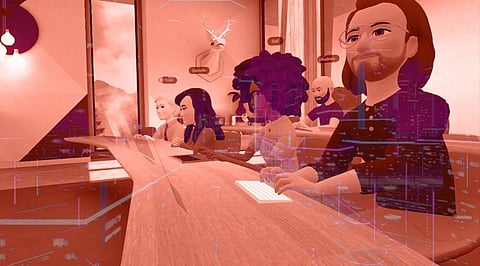

Recently, the CEO of Microsoft, Bill Gates predicted that virtual meetings will be held in the metaverse in forthcoming years. Everyone saw how the world changed during a pandemic, every sector suffered a lot but slowly adopted the new normal. Bill Gates predicts that virtual meetings will no longer be held through 2D camera image grids, but your 3D digital avatars will attend metaverse meetings. This article features how employees can connect in metaverse meetings and the advantages of the metaverse.
Remote work is becoming a trend, so holding virtual meetings on platforms like Zoom, Meet and Teams has quickly become the new normal. However, anyone who has been in any such meeting has experienced its many caveats firsthand. For example, you will usually have to take turns, you can't see each other and there are countless distractions.
Virtual reality offers the opportunity to set an immersive meeting experience with virtual workstations that are fully interactive. It's even better because you can see body language and hear space audio, so you can talk over each other rather than alternating turns. You may use your hands to communicate, which is a big component of how we interact with one another, and then lean in to alter your attention based on posture, which is another important aspect of communication.
The metaverse is often described as the next version of the internet — a shared, virtual space that is persistently online and active. So, how is that any different than an online chatroom?
The term metaverse comes from Snow Crash, a 1992 science fiction novel in which human avatars and software demons inhabit a parallel 3D universe. The Metaverse promises to solve roadblocks in the hybrid workplace — but is it really the silver bullet?
Working in the Metaverse would permit employees to be 100% remote while still allowing for social interactions. For managers, this implies a limitless ability to pool workers from Michigan to Mozambique who can collaborate in a virtual, hyper-practical world. And for employees, this implies they get the opportunity and adaptability to work from any place.
A metaverse work environment could likewise guarantee a more equitable workplace, assisting with balancing the odds between the employees' managers who need to supervise consistently and the individuals who need to work from a distance, if they are single parents, incapacitated, or can't afford to live near the workplace.
Well-being and security also play a role. A recent survey also found that 43% of office workers, either hybrid or full-time, are more worried about exposure to and transmission of COVID than remote workers. For employees of color, 21% lose sleep over it, compared to just 11% of their white counterparts. A Metaverse office implies anybody can come in, vaccinated, unvaccinated, immunocompromised, positive or negative.
And afterward, we can get to the actual offices. Envision a Metaverse office where land is less expensive, and you can set it up on top of a high rise or in the stomach of a whale (virtually) – without a high price tag.
The desk area in the Metaverse is infinitely scalable. Increase or decrease size according to your needs. It's the ultimate customizable space. Virtual meeting rooms or shared lounge areas are configured for the type of work employees do – brainwork or creative brainstorming.
Metaverse real estate companies like The Sandbox are already popping up to stake their claim on this new frontier, and companies like UK media outlet VCCP and Media hub have already set up their Metaverse offices. At the end of the day, employees want flexibility, freedom, and the ability to connect and collaborate easily—and the Metaverse could potentially have it all.
The metaverse can be described as a virtual universe where clients can "live" by utilizing different types of innovation like virtual reality, augmented reality, and artificial intelligence. The thought is that individuals can work, play, and remain associated with companions through different virtual exercises (for example meetings, concerts, events, and so forth)
The thought behind metaverse meetings is that clients would sign into their 3D avatars and walk to the metaverse meeting room as if they were in a physical meeting space in the workplace. For remote employees to appropriately encounter metaverse meetings – they would have to utilize some type of VR goggles (like Oculus) to get full insight into body language, expressions, and voice. Metaverse companies are experiencing users driving demand for more interactive online experiences where they can fully and easily participate in sessions, network with peers, identify new leads and, most importantly, nurture human interaction.
The spread of Covid-19 moved numerous 2020 and 2021 meetings on the web. A few occasions were extraordinary; they used innovation to carry out new encounters with individuals. However, a few virtual occasions missed the mark. The metaverse may end up being the solution. Once completely understood, the metaverse could convey a highly interactive experience where individuals can move uninhibitedly and take part in two-way dialogues without expecting to leave their homes. The metaverse's capacity to rise above location and even languages is one reason it's so exciting. No longer will people need to travel great distances to gather. Among the best benefits of the metaverse is its availability. Whenever done accurately, the metaverse could permit individuals from around the globe to meet up in one space (but on the web) in manners that were beforehand absurd or restrictively expensive.
Join our WhatsApp Channel to get the latest news, exclusives and videos on WhatsApp
_____________
Disclaimer: Analytics Insight does not provide financial advice or guidance. Also note that the cryptocurrencies mentioned/listed on the website could potentially be scams, i.e. designed to induce you to invest financial resources that may be lost forever and not be recoverable once investments are made. You are responsible for conducting your own research (DYOR) before making any investments. Read more here.
